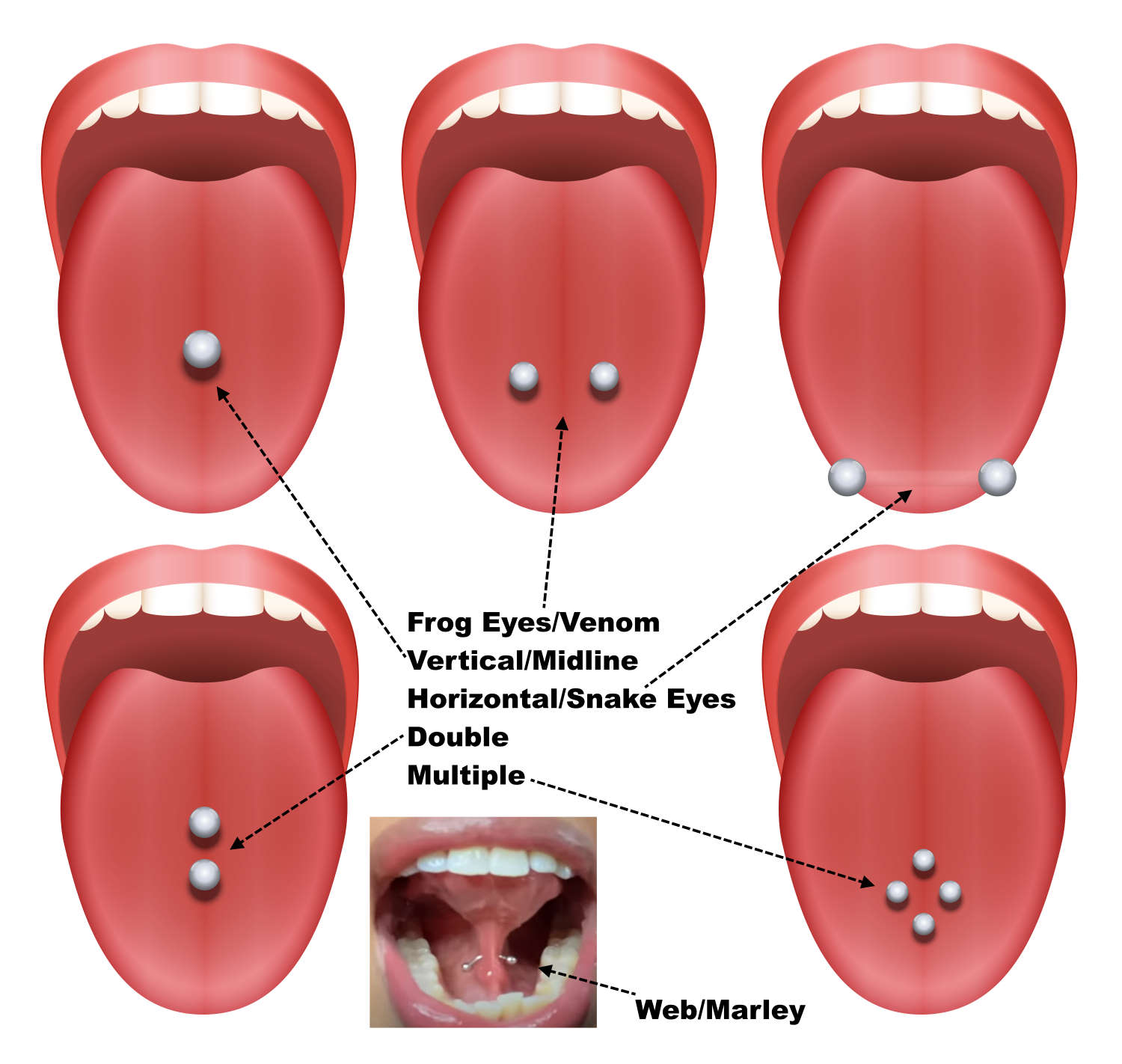
Tongue Piercing: A Complete Rundown Of The Key Elements
Tongue Piercing Article Quick Reference:
History | Myths | Complications | Pain | Cost | Procedure | Healing | Aftercare | Jewelry | Celebrities
A tongue piercing is a type of body piercing that involves inserting jewelry through the tongue. Various locations on the tongue allow for piercings. The midline tongue piercing, also known as the vertical tongue piercing, is located in the middle of the tongue. A piercing placed vertically (up and down) right through the horizontal center of the tongue, refers to the “midline”. The midline is the most popular type of tongue piercing and it will be the main focus of this article.
The other most common types of tongue piercings include the following:
- Double: Two vertical tongue piercings located one in front of the other down the midline of the tongue.
- Snake Eyes/Horizontal: Located on the top side of the tongue closer to the tip and travels horizontally from one side of the tongue to the other.
- Frog Eyes/Venom: Frog eyes refer to two separate piercings closer to the tip of the tongue than the midline and horizontally positioned from one another.
- Marley/Web: A tongue web piercing that goes through the frenulum, which is the webbing beneath the tongue that connects the underbelly of the tongue to the floor of the mouth.
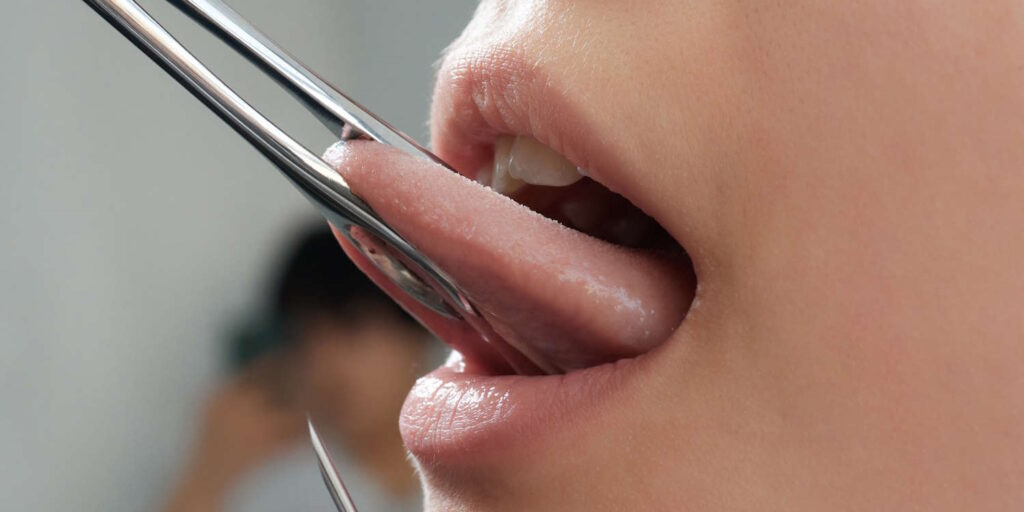
MIDLINE PIERCING HISTORY
Centuries ago, the practice of tongue piercing began, carrying cultural significance across various civilizations. Ancient civilizations like the Aztecs, Mayans, and ancient Egyptians are believed to have started the practice of tongue piercing. They did this as a form of ritual, spiritual, or cultural expression.
In ancient Mayan and Aztec civilizations, priests conducted tongue piercings as a sacred ritual. They believed that piercing the tongue with obsidian or bone needles allowed individuals to communicate with the gods and ancestors. They considered tongue piercing a method to connect with the spiritual realm and gain divine favor.
In ancient Egypt, primarily the ruling class, including Egyptian pharaohs and nobility, practiced tongue piercing. It was considered a symbol of power and status, often using gold or precious metals to showcase wealth and luxury.
Tongue piercing also carries cultural significance in other parts of the world. African and Native American tribes used tongue piercing as a rite of passage or tribal identification. This symbolized strength, bravery, and adulthood within these communities.
Today, tongue piercing has become a widespread form of body modification across various cultures. It serves as an expression of individuality, personal style, and rebellion against societal norms. The placement and jewelry choices have diversified, enabling a broad spectrum of creative and unique expressions through tongue piercings.
DEBUNKING THE MYTHS
There are several myths and misconceptions surrounding tongue piercings that have circulated over time. Let’s debunk a few of them:
- Tongue Piercings Affect Speech And Cause A Lisp: While there might be a temporary adjustment period during the healing process, a properly placed and healed tongue piercing should not affect speech. With time and practice, any initial speech changes should be resolved.
- Tongue Piercings Always Cause Excessive Bleeding: Though not typical, you can manage excessive bleeding with proper aftercare and care from a professional piercer.
- Tongue Piercings Easily Get Infected: Following proper aftercare keeps tongue piercings from getting infected. However, diligent cleaning, rinsing with an appropriate saline solution, and avoiding irritants can significantly minimize the risk of infection.
- Tongue Piercings Lead To Chipped Or Damaged Teeth: While improperly placed jewelry or constant contact with the teeth poses a risk of tooth damage, using shorter jewelry and being mindful of how you interact with the piercing can avoid this. Proper jewelry and care can minimize the risk of tooth damage.
It’s important to remember that everyone’s experience with tongue piercings may vary, and individual healing times and outcomes can differ. To ensure accurate information and guidance, it is always best to consult with a professional piercer who can address any concerns.
TONGUE PIERCINGS AMONG AGES AND GENDERS
A midline piercing is a popular choice among both men and women, and its popularity spans across various age groups. However, it is worth noting that piercing preferences can vary among individuals and cultures, and popularity may fluctuate over time.
In general, tongue piercing has gained popularity among young adults and individuals in their late teens to early twenties. This age group often embraces body modification as a form of self-expression and experimentation.
In recent years, tongue piercing has become more widely accepted and practiced across different age ranges and genders. Men and women of different backgrounds and ages have embraced tongue piercings as a means to showcase their individuality and personal style.
It’s important to remember that piercing preferences are highly personal and can vary widely. People choose to get tongue piercings for a variety of reasons, including aesthetics, cultural significance, or simply as a form of self-expression. Ultimately, the popularity of tongue piercings transcends gender and age, making it a versatile choice for those seeking to adorn their tongues with stylish jewelry.
The minimum age requirement for getting a tongue piercing can vary depending on the laws and regulations of the specific jurisdiction you’re in. In many places, individuals must be at least 18 years old to get a tongue piercing without parental consent. However, age requirements can differ, and some areas may allow individuals under 18 to get a tongue piercing with parental consent.
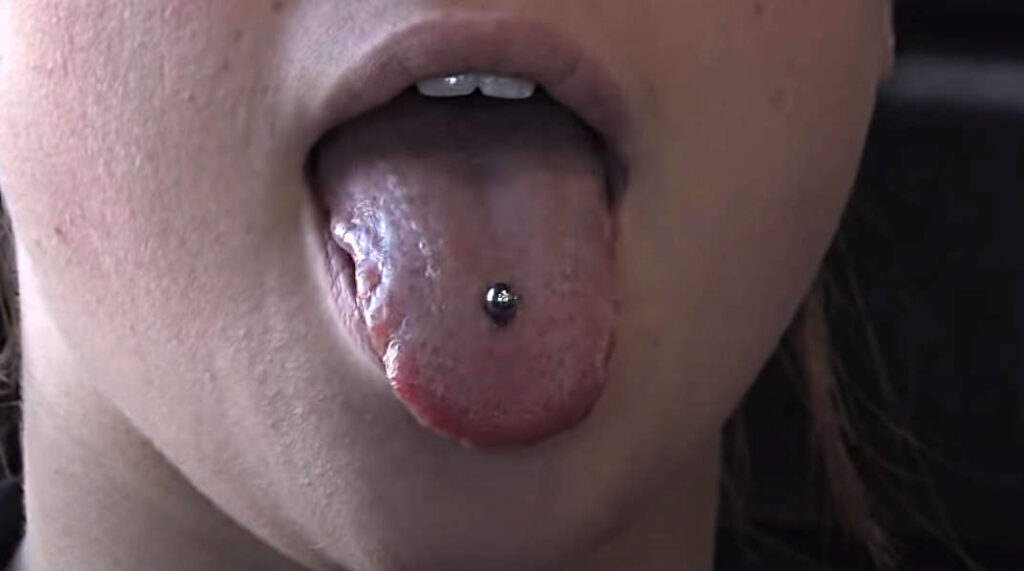
THE MANY RISKS
While a tongue piercing can offer an exciting and visually striking form of self-expression, being aware of the potential risks involved is crucial. Like any body modification, tongue piercings come with certain risks that should not be taken lightly. See some of these below:
- Infection: Tongue piercings can be prone to bacterial or viral infections, which can lead to swelling, pain, and potential complications if not properly treated.
- Swelling And Pain: Immediately after getting a tongue piercing, swelling and pain are common. In some cases, excessive swelling can affect speech, eating, and oral hygiene.
- Bleeding: Tongue piercings can cause bleeding during and after the procedure. While minor bleeding is normal, heavy or prolonged bleeding should be addressed by a professional.
- Damage To Teeth And Gums: Improperly placed or oversized jewelry can cause tooth enamel wear, chips, and gum damage. Chewing on the jewelry can also lead to dental issues.
- Nerve Damage: The tongue contains numerous nerves, and if the piercing is not done correctly, it can damage or irritate these nerves, leading to temporary or permanent numbness or altered sensation.
- Speech Impairment: Initially, tongue swelling can affect speech, causing a lisp or difficulty articulating certain sounds. With time and practice, most people adapt and regain normal speech patterns.
- Gum Recession: Constant rubbing of jewelry against the gums can contribute to gum recession over time, potentially leading to tooth sensitivity or other oral health issues.
- Aspiration or Ingestion Hazards: Loose or poorly secured jewelry can become dislodged and pose a risk of inhalation or swallowing, potentially requiring medical intervention.
It’s essential to consult with a professional piercer, follow proper aftercare instructions, and promptly address any concerns or complications that may arise during the healing process.
ALSO CONSIDER COMPLICATIONS
Before getting a tongue piercing, it’s important to consider the following health conditions and their potential impact on the piercing process and healing:
- Oral Infections: If you have a history of frequent oral infections, such as gum disease or recurring mouth sores, it’s crucial to address these conditions before considering a tongue piercing. Existing infections can interfere with the healing process and increase the risk of complications.
- Bleeding Disorders: Individuals with bleeding disorders, such as hemophilia or von Willebrand disease, should exercise caution when considering a tongue piercing. Such cases heighten the risk of excessive bleeding during the procedure and prolonged bleeding during the healing process.
- Oral Sensitivity Or Pain Disorders: Individuals who experience chronic oral sensitivity, pain disorders like temporomandibular joint (TMJ) disorder, or oral neuropathies should consult with their healthcare provider and piercer to assess the potential impact of a tongue piercing on their condition. Increased oral sensitivity or additional discomfort may occur, and it’s important to evaluate the potential risks and benefits.
- Oral Piercing Contraindications: Certain medical conditions, such as heart murmurs, heart valve issues, or artificial heart valves, may require antibiotic prophylaxis before dental procedures, including oral piercings. Consult with your healthcare provider to determine if any specific precautions need to be taken.
You should always discuss your individual health situation with a healthcare professional or dentist before getting a piercing. They can provide personalized guidance based on your medical history and help you make an informed decision about whether a tongue piercing is suitable for you.
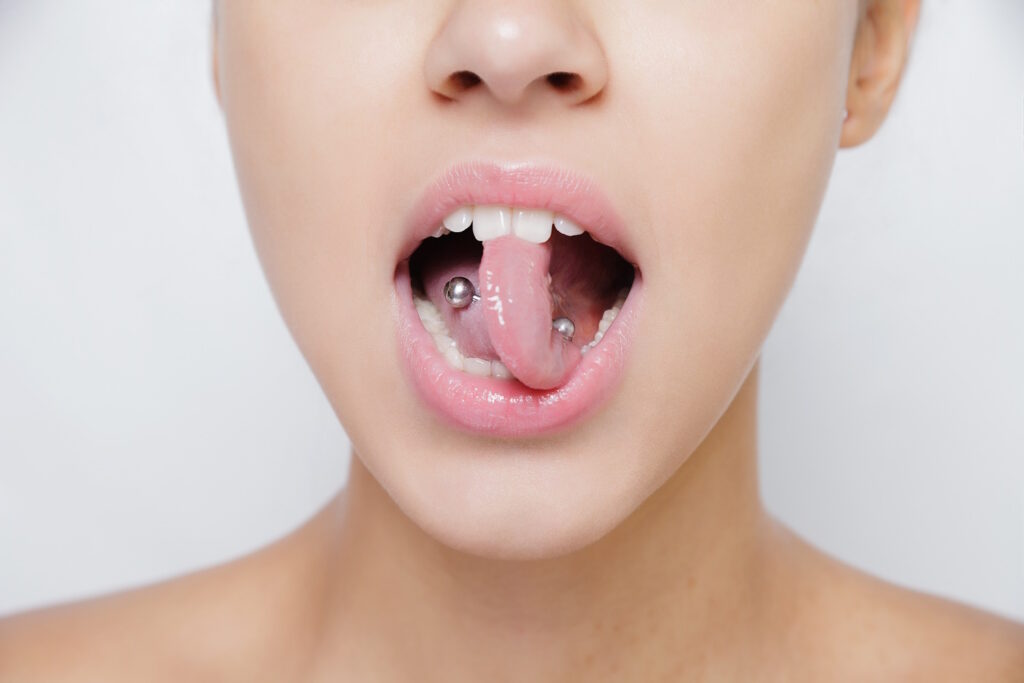
REVERSING A TONGUE PIERCING
In most cases, a tongue piercing will close if you remove the jewelry. Several factors, including the individual’s healing ability, the duration of the piercing, and how recently someone removed the jewelry, can vary the speed at which the piercing closes.
Tongue piercings tend to close relatively quickly compared to other types of piercings due to the rapid healing properties of the tongue tissue. If you remove the jewelry from a well-healed tongue piercing, the hole may start to shrink and close within a matter of hours or days.
However, it’s important to note that the exact closure time can vary from person to person. Some individuals may find that their tongue piercing remains open for an extended period, while others may experience more rapid closure. Additionally, the size of the jewelry used in the piercing may also affect the closure time.
If you are considering removing your midline piercing and want to ensure the hole stays open, it’s advisable to consult with a professional piercer. They can provide guidance and advice on proper jewelry removal techniques and may offer solutions to maintain the piercing opening if desired, such as using a retainer or smaller gauge jewelry.
HOW PAINFUL IS A TONGUE PIERCING?
The pain experienced during a tongue piercing can vary from person to person. It’s generally considered to be a moderately painful piercing due to the sensitivity of the tongue. However, the actual pain experienced is subjective. It can be influenced by factors such as individual pain tolerance, piercing technique, and aftercare practices.
To help manage the pain associated with a tongue piercing, here are some tips:
- Numbing Agents: Some piercers may offer the option of using a topical numbing gel or spray before the piercing. These products can help temporarily numb the area and reduce discomfort during the procedure.
- Breathing And Relaxation Techniques: Practicing deep breathing exercises or other relaxation techniques can help calm nerves and minimize pain perception.
- Cold Compresses: Applying a cold compress or sucking on ice chips before the piercing can help numb the tongue slightly and reduce initial swelling and pain.
- Over-The-Counter Pain Relievers: If necessary, you can consider taking over-the-counter pain relievers such as ibuprofen or acetaminophen before and after the piercing, following the recommended dosage instructions.
- Avoiding Irritants: After the piercing, avoid consuming spicy, acidic, or hot foods and beverages that can aggravate the piercing site and increase discomfort. Stick to cool, soothing liquids and soft foods during the initial healing period.
- Proper Aftercare: Following the aftercare instructions provided by your piercer is essential for promoting healing and minimizing pain.
It’s important to note that everyone’s pain tolerance and healing process can differ, so what works for one person may not work the same for another. If you have any concerns about pain management or the healing process, it’s best to consult with your piercer or a healthcare professional for personalized advice.
TONGUE PIERCING ESTIMATED COST
Ready to get the scoop on the price tag of tongue piercings? Well, hold onto your tongue studs, because I’m about to break it down for you.
- East Coast: (e.g., New York City, Boston, Washington D.C.)
When it comes to the East Coast, you can expect to find a wide range of prices for tongue piercings. On average, you might be looking at around $40 to $80, depending on the studio and the expertise of the piercer. - Midwest: (e.g., Chicago, Minneapolis, St. Louis)
If you’re in the Midwest, you’ll generally find tongue piercing prices more affordable compared to some other regions. The average range for a tongue piercing might fall between $30 and $60. Moreover, budget-friendly options can be found at around $20 to $40. - South: (e.g., Atlanta, Miami, New Orleans, Dallas)
In the southern states, tongue piercing prices are also within a similar range to the Midwest. On average, you can expect to pay around $30 to $60 for a tongue piercing. However, keep an eye out for studios that may offer discounts or package deals, as they can provide you with additional savings. - West Coast: (e.g., Los Angeles, San Francisco, Seattle)
On the West Coast, tongue piercing prices tend to be slightly higher compared to other regions. The average range for a tongue piercing can fall between $50 and $90. However, in trendy metropolitan areas like Los Angeles, San Francisco, or Seattle, you may find upscale studios charging higher prices ranging from $90 to $150.
Keep in mind that these prices are approximate and can vary depending on many factors. These include the reputation of the piercing studio, the experience of the piercer, and the quality of jewelry used.
TONGUE PIERCING: THE NERVE-RACKING PROCEDURE
So, you’ve decided to step out of the box and get a stylish tongue piercing. Excellent choice! However, before you sprint to the closest piercing studio, let’s unpack the procedure. You want to be fully informed about what’s to come. Are you ready? Let’s get started!
- Consultation: Once you’ve pinpointed your ideal studio, arrange a consultation to discuss and get your piercing. The piercer will evaluate your anatomy, answer any inquiries you may have, and assist you in picking out the ideal jewelry.
- Prepping The Area: The piercer will cleanse and sterilize the area in and around your mouth. They may use a mouth rinse or a sterile wipe to make sure everything is spotless.
- Marking The Spot: The piercer will use a surgical pen to mark the placement of the piercing on your tongue. They will try to avoid some of the major blood vessels on the bottom of the tongue. Trust their professional judgment—this is a crucial part of the process.
- Numbing (Optional): If you’re apprehensive about discomfort, you can request a numbing agent. The piercer will apply it to your tongue, and you’ll wait for a while for it to kick in.
- The Main Event: The piercer will employ a sterilized needle to create the piercing hole. Try to remain as calm and as still as possible. You might experience a sudden pinch, a mild burning sensation.
- Inserting The Jewelry: Once the piercing is complete, the piercer will carefully insert the chosen jewelry, usually a barbell. They’ll ensure it’s safe and sits properly in your tongue.
- The Final Instructions: The piercer will provide you with comprehensive aftercare instructions. Adhere to these meticulously to keep your new piercing clean.
Remember, securing a competent piercer and adhering to proper aftercare instructions are essential for a successful piercing.
A CONSIDERABLY FAST HEALING TIME
A tongue piercing typically goes through a relatively quick healing process compared to some other body piercings. This is mainly due to the rapid cell regeneration and the rich blood supply in the area. The initial healing phase, characterized by swelling, tenderness, and possible slight discoloration, generally lasts from 1 to 2 weeks.
During this time, you may have difficulty speaking or eating, and you may also experience an increase in saliva production. It’s essential to maintain a good oral hygiene routine and to follow the aftercare instructions given by your piercer to prevent any complications.
After the first couple of weeks, the piercing should feel significantly better, and most of the initial swelling should have subsided. However, full healing usually takes between 4 to 6 weeks. Even if your piercing seems completely healed before this time, it’s critical to continue with the aftercare routine and to avoid changing the jewelry prematurely to prevent issues like infection or piercing rejection.
In some cases, it could take up to 8 weeks for the piercing to fully heal. The exact healing time varies from person to person, influenced by factors such as individual health, adherence to aftercare instructions, and whether or not the piercing experiences any complications, like infection or trauma.
Remember that getting a midline piercing involves creating a wound in your body, and it needs time to heal properly. Patience and proper care are key to a successful and healthy piercing healing process.
TONGUE PIERCING AFTERCARE
Caring for your new tongue piercing is crucial to avoid complications and ensure a smooth healing process. Here are some tips for tongue piercing aftercare:
- Maintain Oral Hygiene: Brush your teeth twice a day as you normally would, but be gentle around the piercing area. Use a new, soft-bristled toothbrush to minimize bacterial contamination.
- Mouth Rinse: Rinse your mouth with an alcohol-free mouthwash after every meal and before bedtime. You can also use a warm saline solution (sea salt mixed with water) to rinse your mouth 2-3 times a day.
- Avoid Oral Contact: Until completely healed, avoid oral contact such as kissing and oral sex.
- Avoid Spicy, Acidic, and Hot Foods: Spicy, acidic, and hot foods can cause discomfort and potentially delay the healing process. Stick to soft, cool foods like yogurt and ice cream for the first few days.
- Stay Hydrated: Drinking cold water can help reduce swelling and keep the area clean. It also helps to suck on small ice chips or popsicles.
- Don’t Smoke or Drink Alcohol: Smoking can delay the healing process and increase the risk of infection. Avoid alcohol because it causes swelling.
- Avoid Playing With The Jewelry: Moving the jewelry around can cause trauma to the piercing, delay healing, and lead to complications such as infection or migration.
Remember, healing times can vary, and some discomfort, swelling, and changes in saliva production are normal. This is especially true in the first few weeks. If you experience severe pain, excessive swelling, or signs of infection, or persistent redness, seek medical attention immediately. It’s better to be safe than sorry when it comes to your health!
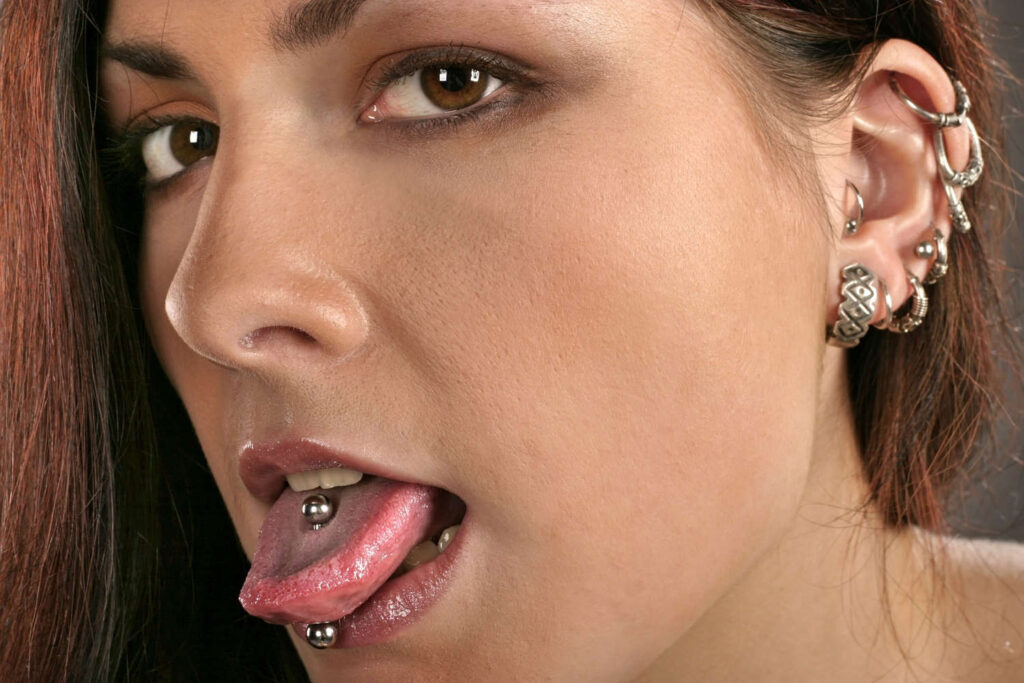
THE JEWELRY SWITCHEROO
After getting a tongue piercing, it’s usually recommended that you wait until the piercing is fully healed before changing the jewelry. This typically takes around 4 to 6 weeks, although it could take up to 8 weeks for some individuals. It’s best to consult with your piercer before making any changes, as they can assess the healing process and guide you appropriately.
When it comes to changing your tongue piercing jewelry, here are some tips to make it easier:
- Cleanliness Is Key: Before you begin, wash your hands thoroughly with antibacterial soap. Also, clean the new jewelry and ensure your mouth is clean too. You can use a mild, alcohol-free mouthwash for this.
- Prepare Your Space: Have a clean, well-lit area to change your jewelry. Having a small mirror might also be helpful.
- Loosen the Barbell: Stick your tongue out in front of a mirror, grab the bottom ball of the jewelry with one hand, and then use your other hand to unscrew the top ball in a counterclockwise direction.
- Take it Slow: Be gentle and take your time while removing the jewelry. Hurrying could potentially cause harm.
- Switch Quickly: Once the old jewelry is out, put in the new jewelry as quickly as possible. This will prevent the hole from shrinking.
- Tighten Securely: Once the new jewelry is in, make sure the balls are tightened securely. This will prevent them from coming loose accidentally.
- Aftercare: After changing the jewelry, rinse your mouth with an alcohol-free mouthwash to keep the area clean.
Remember, if at any point you’re uncomfortable doing this yourself or run into difficulties, don’t force it. Go to a professional piercer for help. It’s better to be safe and avoid causing any damage to the piercing area.
TONGUE PIERCING JEWELRY IDEAS
When choosing jewelry for your tongue piercing, it’s crucial to select high-quality materials that are safe for your body. Here are some materials commonly used for tongue jewelry:
- Surgical Steel: Also known as 316L or 316LVM stainless steel, this is one of the most common and safe materials used in body jewelry. It’s hypoallergenic, durable, and resistant to scratching and tarnishing.
- Titanium: This is a lightweight and highly biocompatible material. it’s less likely to cause allergic reactions compared to other metals. It’s also strong and resistant to scratches and tarnish.
- 14K or 18K Gold: While gold is a popular choice due to its aesthetic appeal, ensure it’s solid gold and not gold-plated. Gold-plated jewelry can chip and expose the underlying metal, which might cause an allergic reaction. Stick to 14K or 18K gold, as higher karat gold can be too soft for a new piercing.
- Niobium: Niobium is similar to titanium but slightly heavier. It’s hypoallergenic and can be anodized to produce a variety of vibrant colors, just like titanium.
- Acrylic: Acrylic jewelry is lightweight and comes in a variety of colors and designs. However, it’s generally recommended for fully healed piercings and short-term wear, as it can harbor bacteria and may not be as durable as metal jewelry.
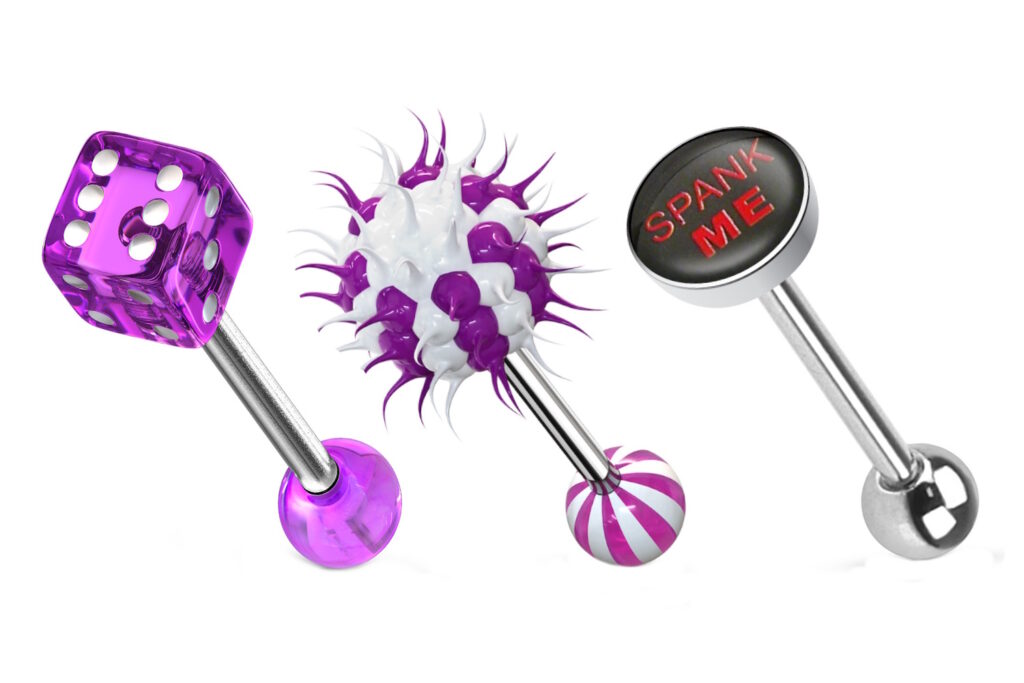
TONGUE PIERCING STYLES
Regarding styles, here are some popular choices for tongue piercings:
- Straight Barbells: The most common type of body jewelry for a tongue piercing includes straight barbells. It consists of a straight bar with balls (or other shapes) at both ends. The balls, usually made from the same material as the bar, include materials like acrylic or gemstones for a different look.
- Internally Threaded Barbells: These are similar to straight barbells, but the threading is on the inside of the bar. This design minimizes irritation upon jewelry insertion.
Remember, no matter what material or style you choose, it’s crucial to select the correct size. Too long or too short can cause discomfort or complications. Your professional piercer can guide you in choosing the right size for your jewelry.
10 CELEBRITY TONGUE PIERCINGS
Here’s 10 celebrities that have or have had a tongue piercing.
- Mel B: Melanie Brown, also known as Mel B or Scary Spice from the Spice Girls, has been known for her tongue piercing. The piercing has been part of her bold and audacious persona.
- Christina Aguilera: The pop icon and former ‘The Voice’ judge has also had a tongue piercing. Known for her powerful vocals and dynamic style, the piercing added to her edgy image during her early career.
- Jamie Foxx: The Oscar-winning actor and singer Jamie Foxx has had a tongue piercing, which contributes to his charismatic and unique persona.
- Dennis Rodman: The former NBA player, known for his individualistic style and colorful hair, also sported a tongue piercing. His personal style often defied the conventional look of athletes.
- Rihanna: The multi-platinum-selling artist has been known for her numerous piercings, and her tongue piercing adds to her daring and unconventional style.
- Ke$ha: The pop singer Ke$ha has been spotted with a tongue piercing, adding to her unconventional and rebellious image.
- Miley Cyrus: Known for her evolving and daring personal style, Miley Cyrus had a tongue piercing as part of her transformation from a Disney Channel star to a bold pop icon.
- Pink: The singer Pink, known for her punk-influenced style and bold persona, has also been known to sport a tongue piercing.
- Steve-O: The ‘Jackass’ star and stunt performer Steve-O, renowned for his wild stunts and daring persona, has a tongue piercing.
- Jesse Metcalfe: The ‘Desperate Housewives’ star Jesse Metcalfe has been spotted with a tongue piercing, which added to his edgy, bad-boy image on screen.
Remember, while these celebrities sport tongue piercings, making decisions about body modifications should be based on your personal comfort.

STILL WANT A TONGUE PIERCING?
Navigating the decision of a tongue piercing, a unique and bold statement, requires careful consideration. These include selecting a reputable piercing studio and mindful choice of jewelry. Each step in this process is crucial for safety and success. Rigorous aftercare, crucial to prevent infections and ensure optimal healing, should not be overlooked.
Even though tongue piercings heal relatively quickly, rushing is not advisable. Always consult with a professional before altering your jewelry. While celebrity inspiration can help define your style, your piercing should reflect your personality and comfort. A tongue piercing is not just a style statement, but a commitment to body care. If you’re ready for this responsibility, embrace the journey, showcase your piercing with pride, and enjoy its unique impact on your persona.
Need to find a piercer? Check out the Association of Professional Piercers.
Author: Scott S.

